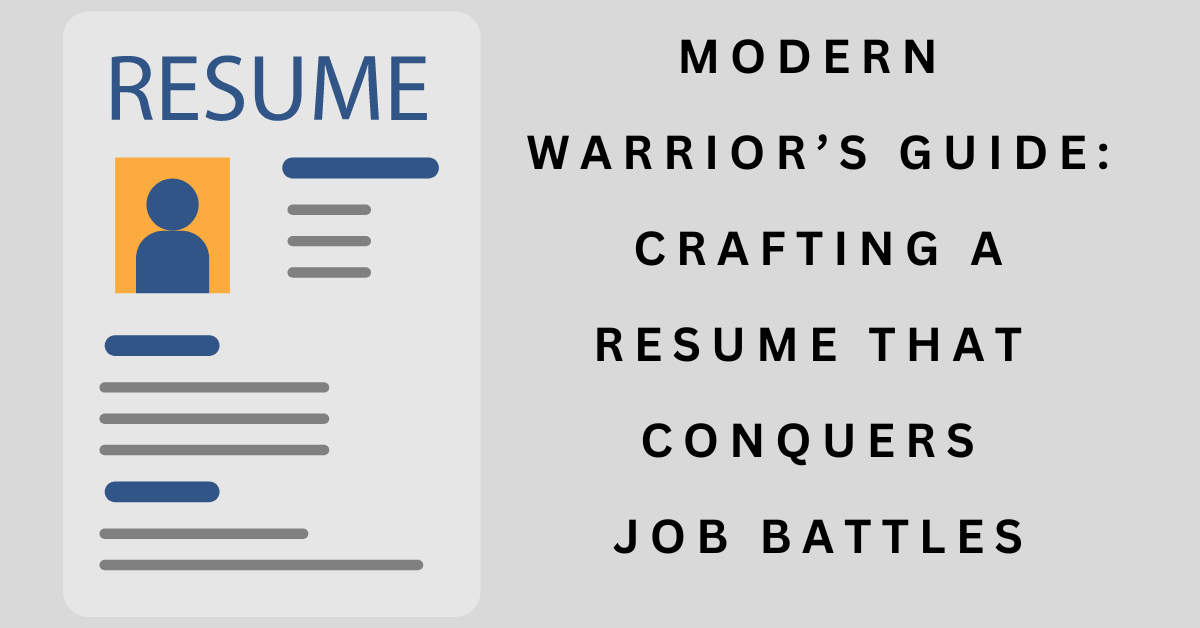Education
Modern warrior’s guide: crafting a resume that conquers job battles

In today’s fiercely competitive job market, crafting a standout resume is more crucial than ever. Like a modern warrior preparing for battle, you must equip your resume with the right tools and strategies to conquer your job search. Here’s a comprehensive guide to creating a resume that highlights your skills and experiences and makes you irresistible to employers.
1. Understanding Your Battlefield: Tailor Your Resume
Before you begin writing your resume, understand the industry and the specific job you are applying for. This requires thorough research to tailor your resume to fit the job description. Use the same keywords and phrases that appear in the job listing. This not only shows that you are a perfect fit but also helps your resume pass through Applicant Tracking Systems (ATS), which are used by employers to filter resumes based on specific keywords.
2. Choose Your Weapons: Select the Right Resume Format
There are several resume formats to choose from, each serving a different purpose:
- Chronological: Lists your work history in chronological order. Best for those with a strong, consistent work history.
- Functional: Focuses on skills and experience, rather than chronological work history. Ideal for career changers or those with gaps in employment.
- Combination: Blends both chronological and functional formats. Suitable for those with relevant skills and a solid work history.
Choose the format that best showcases your strengths and aligns with your industry.
3. Forge Your Armor: Crafting Compelling Sections
- Header: Start with a strong header including your name, contact information, and a professional title or branding statement.
- Professional Summary: Replace the outdated objective statement with a powerful summary of your skills and value. Highlight your career achievements and skills in a few concise sentences.
- Skills Section: List your technical and soft skills. Customize this section for each job you apply for based on the required skills listed in the job description.
- Professional Experience: Use action verbs to describe your responsibilities and achievements. Quantify your accomplishments with data and statistics when possible.
- Education: Include degrees and relevant certifications. Recent graduates should place education before experience; experienced professionals should do the opposite.
- Additional Sections: Depending on your industry, you might also want to include sections for publications, conferences, licenses, or professional affiliations.
4. Sharpen Your Sword: Fine-Tuning Your Content
- Be Concise: Keep your resume to one or two pages. Only include information that is relevant to the job.
- Use Action Verbs: Words like “achieved,” “managed,” “developed,” and “designed” demonstrate your capability to produce results.
- Quantify Achievements: Numbers provide concrete evidence of your capabilities and results. For example, “increased sales by 20% within one year.”
- Avoid Jargon: Unless it is common in your industry, avoid using jargon and acronyms that might not be understood by HR managers.
5. Guard Up: Proofreading and Editing
Thoroughly proofread your resume to avoid any grammatical or typographical errors. These mistakes can make you appear careless and unprofessional. Use tools like Grammarly, or have a trusted friend or professional review your resume.
6. Test Your Weaponry: Seeking Feedback
After polishing your resume, test its effectiveness by seeking feedback from professionals in your field. Use their input to make final adjustments before sending your resume into the battlefield of job applications.
7. Prepare for Battle: Customizing and Applying
Customize your resume for each application. Pay attention to the details in the job description and make sure your resume addresses the specific qualifications and experiences the employer is seeking. Use a cover letter to elaborate on how your skills directly relate to the job.
Crafting a resume is like preparing for a strategic battle. Each section of your resume should be meticulously crafted and tailored to showcase your strengths and unique qualifications. By following these guidelines, you ensure that your resume not only passes the scrutiny of ATS systems but also captures the attention of hiring managers, helping you win the war of landing your dream job.
Education
Boosting Sales in the Educational Sector With Bulk Journals

The educational sector is a hotspot for many businesses that sell school-related products. This includes stationery tools like paper, pens, and journals. Students, especially, love customized stationery. Not only that, but schools also often require standardized journals to be distributed to students. This is why the educational sector offers immense potential for businesses selling customized journals.
By understanding the buying cycles of educational organizations and offering competitive pricing, businesses can tap into bulk journals with the academic sector to make a proper profit.
Why Target Educational Institutions?
Schools and colleges have ongoing needs for journals, planners, and notebooks. These tools are essential for student organization, academic planning, and teacher lesson preparations. Custom bulk journals tailored to the academic year’s structure or student preferences are in high demand.
Targeting schools ensures steady bulk orders and helps businesses establish long-term relationships with institutions. A reliable supplier becomes a go-to partner for yearly procurement needs.
Understanding Academic Buying Cycles
Educational institutions often operate on strict schedules for purchases. The academic buying cycle typically aligns with school terms and fiscal budgets. Key periods include:
- Summer and Early Fall: Schools prepare for the new academic year and order student supplies.
- End of the Year: Teachers and administrators stock up for the next term or purchase gifts for staff appreciation.
Businesses targeting this sector should plan marketing efforts and promotions to align with these cycles. Advanced planning also allows institutions to budget for larger purchases.
Bulk Pricing Structures for Schools
Educational institutions are budget-conscious and prefer suppliers offering bulk discounts. Competitive pricing structures can set businesses apart. Key considerations include:
- Tiered Discounts: Offering discounts based on the quantity purchased ensures schools save more when ordering larger orders.
- Customized Options at Lower Costs: Providing customization at reduced rates for bulk orders increases appeal.
- Subscription Models: Some schools benefit from annual contracts, guaranteeing recurring business for the supplier.
Being transparent about pricing and offering flexible payment terms can help build trust with school administrators.
Specialized Academic Planners and Student Journals
Tailoring products to the needs of schools can significantly boost sales. Two popular products for educational institutions include:
- Academic Planners: Designed for students and teachers, these planners include class schedules, assignment trackers, and school calendar pages. Businesses can customize them with the institution’s name, logo, and colors.
- Student Journals: Durable journals suited for daily use are students’ staples. Customizable covers and inspirational designs make them appealing to learners.
Adding features like pre-printed timetables or motivational quotes can enhance the value of these products.
Tips for Selling Bulk Journals to Educational Institutions
- Highlight Durability: Ensure journals are designed to withstand daily student use.
- Offer Samples: Free samples allow schools to assess quality before committing to a large order.
- Emphasize Customization: Schools appreciate journals tailored to their branding and academic needs.
- Be Accessible: Establish dedicated communication channels to handle queries from busy school administrators.
Key Takeaways
Selling bulk journals to educational institutions requires understanding their unique needs, academic cycles, and budget constraints. Businesses that offer tailored academic planners, competitive pricing, and high-quality products can build lasting relationships with schools. By aligning with educational priorities, suppliers can secure consistent orders and establish themselves as reliable partners in the academic world.
Education
The Benefits of Completing Court-Ordered Courses Online: Convenience and Compliance

Introduction
In today’s digital age, fulfilling court-mandated educational requirements has never been more accessible. Online courses designed for court orders offer a streamlined way for individuals to accomplish their legal obligations while accommodating their busy lives. This format not only promotes efficiency but also ensures compliance with court mandates. With the rise of digital education platforms, individuals can now complete court-ordered classes without the logistical challenges that traditional classroom settings might pose.
Convenience of Online Learning
One of the most significant advantages of completing court ordered classes online is the unparalleled convenience it offers. Whether you must take a course on anger management, substance abuse, or any other mandated topic, online platforms provide a user-friendly interface that can be accessed anytime, anywhere. This eliminates the need to commute to a physical location, saves time, and reduces the stress associated with travel.
The digital approach allows participants to integrate learning into their daily routines, ensuring they meet their legal requirements without causing significant disruptions to work or family commitments. This convenience is a key factor in promoting adherence to court orders, as individuals are likelier to engage with a program that fits seamlessly into their lifestyle.
Flexibility and Accessibility
Flexibility is another hallmark of completing court-ordered courses online. With 24/7 availability, these courses empower learners to choose when and where they study. This adaptability is especially beneficial for those with varying work schedules, caregiving responsibilities, or other personal commitments that make attending traditional classes challenging.
Online courses also cater to different learning preferences. Interactive modules, videos, and quizzes allow individuals to absorb material in ways that resonate best with them. This variety can enhance comprehension and retention, ensuring participants meet legal requirements and gain valuable insights and skills.
Ensuring Timely Compliance
Meeting deadlines is crucial when it comes to court-ordered education. Online courses are structured to support timely compliance, often including automated reminders and progress-tracking features that help participants stay on schedule. These tools add a layer of accountability, ensuring that individuals can continuously monitor their advancement through the course.
Additionally, online platforms often provide immediate access to completion certificates once the course is finished. This prompt delivery alleviates concerns about documentation, allowing individuals to present proof of compliance to the court without delay. As a result, participants can fulfill their legal obligations with confidence and peace of mind.
Structured Curriculum and Support
While flexibility is a significant advantage of online courses, their structured curriculum ensures that all relevant material is comprehensively covered. These courses are meticulously designed to address the court’s specific requirements, providing a transparent roadmap for participants to follow.
Moreover, online courses frequently include access to support resources, such as knowledge bases and customer service representatives, who can assist with technical issues or questions about the course content. This support network can help participants navigate any challenges, further facilitating the completion of their court-ordered programs.
Privacy and Confidentiality
Privacy is a significant consideration for individuals enrolled in court-ordered courses. Online learning platforms typically offer a layer of confidentiality that traditional classrooms may not. Participants can work through sensitive material in the comfort and privacy of their own homes without the potential stigma of attending in-person classes.
This private environment allows individuals to engage more openly with course content, fostering a more thorough understanding of the material and encouraging personal growth. Furthermore, online platforms often adhere to strict data protection policies, ensuring that personal information remains secure throughout the course.
Conclusion
In summary, completing court-ordered courses online presents several compelling advantages that make compliance both convenient and feasible. The flexibility, accessibility, and structured support that online platforms offer ensure that individuals can meet their legal obligations efficiently and with ease. As more people turn to digital solutions for their educational needs, online court-ordered courses continue to prove themselves as a reliable and effective means of achieving compliance while fostering personal development.
Education
Navigating School Changes: Practical Tips for a Smooth Transition Mid-Year

Deciding to change a child’s school mid-way through the academic year is a decision that can carry substantial weight for many families. This choice often involves multiple personal, academic, or situational reasons, ranging from relocation due to job assignments to seeking a more suitable educational setting for the child. For those considering transfering schools, the process can initially seem overwhelming. However, with strategic planning and robust support systems, the transition can become a rewarding and positive experience that academically and socially benefits the child. This comprehensive guide explores the reasons behind mid-year school changes and the various challenges families may encounter. It offers pragmatic steps to ensure students adjust smoothly and thrive in their new educational environments.
Why Change Schools Mid-Year?
Families often consider switching schools in the middle of the year for many reasons. A typical driver is a geographical relocation due to new job opportunities or changes in family dynamics that necessitate moving. Additionally, educational motivations play a significant role; parents might search for schools offering specialized programs, advanced academic courses, or a focus on particular disciplines such as the arts, sciences, or sports. These driving factors highlight families’ need to evaluate the alignment of a new school’s offerings with the student’s passions and academic goals.
Social and emotional factors also compel school changes. A child might face unsupportive environments such as bullying, insufficient resources for learning disabilities, or lack of social connection with peers. For these reasons, families may seek more supportive, inclusive, and nurturing environments where their children can thrive personally and academically.
Common Challenges Faced by Families
Transitioning to a new school halfway through the academic year is no small feat and can be accompanied by various logistical and emotional challenges. From organizing new daily routines and understanding a different curriculum to the administrative paperwork involved in enrolling in a new school, the logistical components can be fairly demanding. These challenges necessitate meticulous planning and time management from all family members involved.
The emotional impact on children cannot be understated. Leaving behind established friendships and familiar routines can be a source of stress and anxiety. Kids must acclimate to new social dynamics, establish relationships with new peers, and navigate varying educational expectations. Parents should strive to monitor their children’s emotional well-being closely, maintaining open dialogues to reassure them that they are supported and valued during this transition.
The Benefits of Switching Schools
While the process involves challenges, changing schools can be incredibly advantageous under the right circumstances. A new school may offer previously unavailable opportunities, such as access to specialized courses, extracurricular activities, or unique educational philosophies that align better with a child’s strengths and interests. It can allow children to rediscover their potential and explore subjects and hobbies they are passionate about. Narratives abound of children who have relocated mid-year only to find themselves in environments where they truly excel and connect with peers with similar aspirations. This new setting might stimulate personal growth and academic achievement, opening doors to pathways that were previously out of reach in their former schools.
Preparing for the Transition
Preparation is critical to a smooth school transition. It begins by thoroughly investigating prospective schools to understand their culture, educational standards, and available resources. Scheduling visits to the new school can also provide a sense of familiarity and comfort. During these visits, engaging with faculty and staff to address any curriculum differences and gauge the support systems available for students is beneficial.
Involving the whole family in discussions about the potential change helps everyone feel invested in the decision. By doing so, children can express their thoughts and feelings regarding the move, reinforcing family bonds and giving a sense of ownership over the future.
First Days in a New School
The first few days in a new school are a critical period for setting the tone of the transition. Encouraging children to participate in school events, athletic teams, or clubs that reflect their interests can help them find common ground with fellow students and promote a sense of belonging. This participation fosters new friendships, builds confidence, and improves social skills. Parents can aid this process by ensuring their children have positive daily interactions, discussing their school day openly, helping to highlight positive experiences and offering guidance on handling any challenges they may encounter.
Supporting Your Child Academically
Ensuring academic continuity is essential during this time of change. It requires understanding the new school’s academic expectations and identifying differences in curricula. Regular parent-teacher conferences can be instrumental in establishing a line of communication between parents and educators, helping identify areas where a student may need extra support or enhancement. At home, creating a structured learning environment that mirrors school habits aids in maintaining consistency and stability. Recognizing and celebrating academic efforts can inspire students to tackle new educational challenges positively.
Handling Emotional Adjustments
It’s crucial to address the emotional health of children during a school change. Children might exhibit signs of stress or resistance, which is normal. Parents should keep an open line of communication, listening to their child’s concerns and validating their feelings. Resources like therapy or counseling services are beneficial if needed, offering a secure environment for learners to examine their feelings and cultivate coping mechanisms. Support systems such as peer mentorship programs or counseling can reinforce positivity and self-esteem, ensuring children have the tools to acclimate successfully to their new environment.
Long-term Considerations
The transition doesn’t conclude immediately; it’s an ongoing process that requires continuous support and adjustment. Regular check-ins with your child regarding their academic progress and social interactions can help identify lingering challenges. In summary, although switching schools mid-year can be demanding, it also offers a unique chance for children to embrace new experiences and achieve personal growth. With structured support and proactive involvement, parents can successfully guide their children through this transitional phase and harness the potential for a bright, fulfilling educational journey.

 Cartoon1 year ago
Cartoon1 year agoUnlocking the Potential of Nekopoi.care: A Comprehensive Guide

 Game1 year ago
Game1 year agoExploring Aopickleballthietke.com: Your Ultimate Pickleball Destination

 BUSINESS1 year ago
BUSINESS1 year agoWhat Companies Are In The Consumer Services Field

 BUSINESS11 months ago
BUSINESS11 months agoUnraveling the Mystery of 405 Howard Street San Francisco charge on Credit Card

 HOME IMPROVEMENT1 year ago
HOME IMPROVEMENT1 year agoVtrahe vs. Other Platforms: Which One Reigns Supreme?

 TECHNOLOGY11 months ago
TECHNOLOGY11 months agoThe Guide to Using Anon Vault for Secure Data Storage

 ENTERTAINMENT8 months ago
ENTERTAINMENT8 months agoUnderstanding Bunkr Album: A Comprehensive Guide

 ENTERTAINMENT1 year ago
ENTERTAINMENT1 year agoThe Epic Return: Revenge of the Iron-Blooded Sword Hound
















